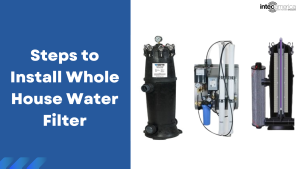Getting clean and safe water for drinking and other domestic chores is of utmost importance in terms of health and hygiene, as well as a basic human right. The quality of water, irrespective of its sources, has always been the priority as water is not fit for consumption even in its original form through rains. Also, it mixes with suspended impurities and bacteria during transportation from the water source via pipelines to faucets at home. So, the water you get from your faucet, although treated, may not be pure. This is where water treatment systems like whole house water filtration systems make a significant difference. The whole house filter removes harmful contaminants from the water and makes it fit for consumption. Whole house water filters offer undeniable benefits if installed properly. This post introduces the readers to the whole house water cartridge filter installation guide in detail.

How to install whole house water filter?
Before getting into the water filter installation process, make sure you have turned off the main power supply and drained the existing water. Also, it would help if you had a basic understanding of plumbing and the tools required to accomplish the task. Here are some important pointers that will ease your installation process. So, let’s have a look at them.
- The first and foremost important thing is to select an accessible location. The system comprises a sediment pre-filter unit that catches dirt and dust particles, and a second filter unit has a carbon filter to remove other contaminants.
- The whole house filter cartridges need to be changed usually twice in a year; hence, the location you choose must be easy to reach. Choose the location near the main shut-off valve. Ensure the water filtration system should be installed in line with the existing plumbing line.\
- Once the location is fixed, mark the section on the pipes which fits in well with the water filter system. With the help of the right cutting tools, such as a pipe cutter, cut and remove the precisely marked area, and do not forget to keep a container to prevent spilling.
- Install shut-off valves to separate the units, and a by-pass valve, which will allow the water to be used when filters are being changed. If you would like to monitor input and output pressure, install a pressure gauge right next to each shut-off valve. This way, you will get an idea of when to change filters.
- Once done, carefully follow the OEM’s instructions on installing the compression nuts, and plastic or brass fittings.
- Next, place the whole house water filter at the marked position and check its functionality, so the water enters through the in port and exits through the out port.
Now, it’s time to check for leaks. Turn off the system’s inlet valve and switch on the main water supply. Tighten filter housings and fittings if required. Turn on the inlet valve and check if there is any leakage. Once ensures you’re done with the installation process.
All steps required to install whole house water filtration systems are detailed here. Individuals can follow these straightforward steps to install whole house water filters in their homes. If you are not comfortable doing it yourself (DIY), then it is always recommended to consult an experienced industry player from this segment. Intec America is one of the prominent industry players in this segment. With vast years of market presence and skilled employees, the company provides various water filtration solutions across industries. Also, the team of experts will assist you throughout the selection and installation phases.
Frequetnly Asked Question About Whole House Water Filtration
1. What is the best location to install a whole house water filter?
The best location to install a whole house water filter is after the main water line enters the house and before the water heater. This will ensure that all the water entering the house is filtered.
2. What type of filter is suitable for my home’s water supply?
The type of filter suitable for your home’s water supply depends on the contaminants present in the water. Some popular types of filters include carbon, reverse osmosis, and sediment filters. It’s recommended to get your water tested to determine the best filter for your needs.
3. How often do I need to replace the filter cartridge?
The frequency of filter cartridge replacement depends on the type of filter and the water usage in your home. Generally, filter cartridges need to be replaced every 6-12 months.
4. Can I install the filter system by myself or do I need a professional plumber?
Installing a whole house water filter system can be a complex process and it’s recommended to hire a professional plumber. They have the experience and tools to ensure the filter is installed correctly and effectively.
5. Will installing a whole house water filter increase my water pressure ?
Installing a whole house water filter system may slightly reduce water pressure due to the additional resistance in the water line. However, this reduction is usually negligible and not noticeable in most homes.
Recent Blog Posts
- Undersink Filters vs Whole House Water Filtration Systems – Know the Real Difference
- Things You Must Know About pH Control and Drinking Water Treatment
- Tips to Maintain Water Storage Tank and Keep Water Fresh
- Reasons to Avoid Pool Water Care Chemicals
- Seasonal Pool Maintenance Costs and Chlorine Alternatives for Pool Sanitization


